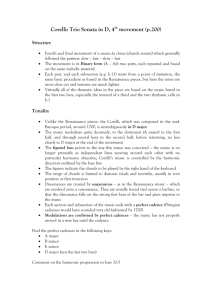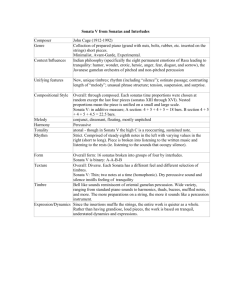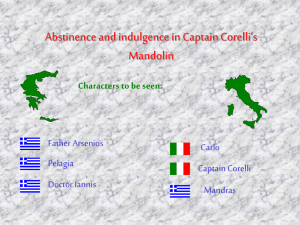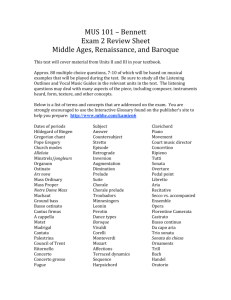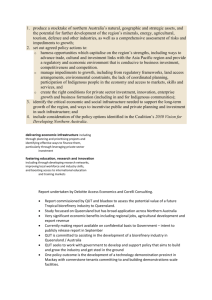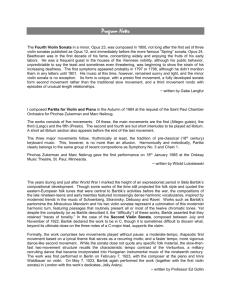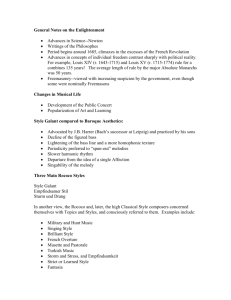Rome: Corelli and Geminiani
advertisement
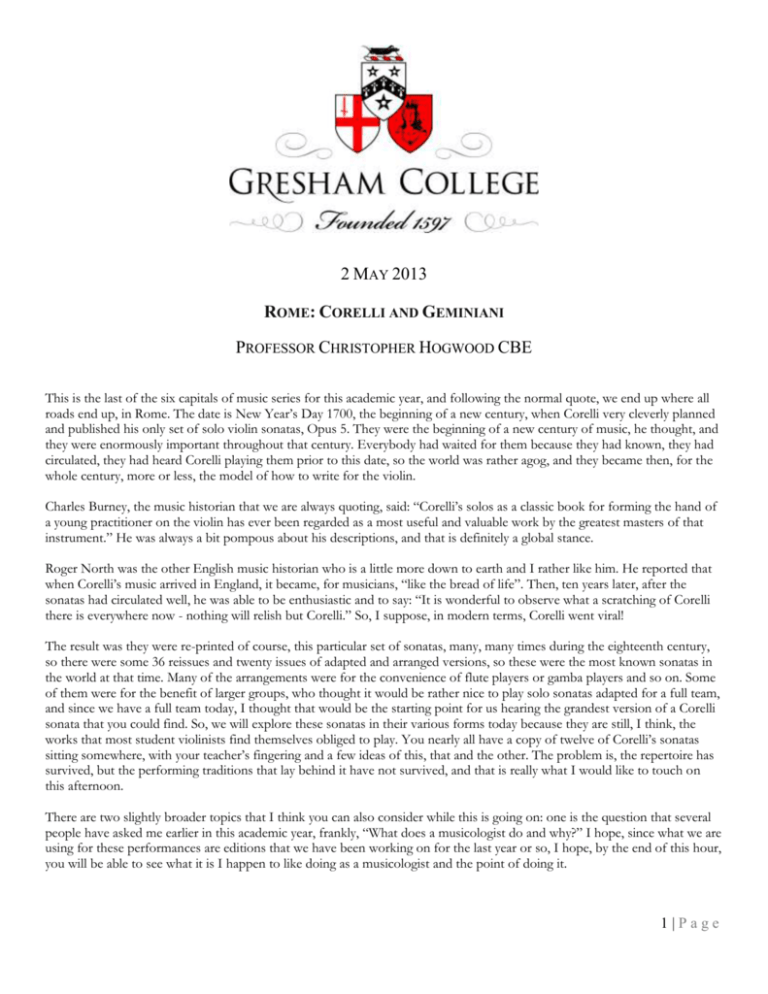
2 MAY 2013 ROME: CORELLI AND GEMINIANI PROFESSOR CHRISTOPHER HOGWOOD CBE This is the last of the six capitals of music series for this academic year, and following the normal quote, we end up where all roads end up, in Rome. The date is New Year’s Day 1700, the beginning of a new century, when Corelli very cleverly planned and published his only set of solo violin sonatas, Opus 5. They were the beginning of a new century of music, he thought, and they were enormously important throughout that century. Everybody had waited for them because they had known, they had circulated, they had heard Corelli playing them prior to this date, so the world was rather agog, and they became then, for the whole century, more or less, the model of how to write for the violin. Charles Burney, the music historian that we are always quoting, said: “Corelli’s solos as a classic book for forming the hand of a young practitioner on the violin has ever been regarded as a most useful and valuable work by the greatest masters of that instrument.” He was always a bit pompous about his descriptions, and that is definitely a global stance. Roger North was the other English music historian who is a little more down to earth and I rather like him. He reported that when Corelli’s music arrived in England, it became, for musicians, “like the bread of life”. Then, ten years later, after the sonatas had circulated well, he was able to be enthusiastic and to say: “It is wonderful to observe what a scratching of Corelli there is everywhere now - nothing will relish but Corelli.” So, I suppose, in modern terms, Corelli went viral! The result was they were re-printed of course, this particular set of sonatas, many, many times during the eighteenth century, so there were some 36 reissues and twenty issues of adapted and arranged versions, so these were the most known sonatas in the world at that time. Many of the arrangements were for the convenience of flute players or gamba players and so on. Some of them were for the benefit of larger groups, who thought it would be rather nice to play solo sonatas adapted for a full team, and since we have a full team today, I thought that would be the starting point for us hearing the grandest version of a Corelli sonata that you could find. So, we will explore these sonatas in their various forms today because they are still, I think, the works that most student violinists find themselves obliged to play. You nearly all have a copy of twelve of Corelli’s sonatas sitting somewhere, with your teacher’s fingering and a few ideas of this, that and the other. The problem is, the repertoire has survived, but the performing traditions that lay behind it have not survived, and that is really what I would like to touch on this afternoon. There are two slightly broader topics that I think you can also consider while this is going on: one is the question that several people have asked me earlier in this academic year, frankly, “What does a musicologist do and why?” I hope, since what we are using for these performances are editions that we have been working on for the last year or so, I hope, by the end of this hour, you will be able to see what it is I happen to like doing as a musicologist and the point of doing it. 1|Page The other question that you could ponder while the music is going on is this question that philosophers love to place in front of you, asking, “When you describe a piece of music, a Corelli sonata, is it an object, an artefact, something you take off the shelf and look at and point at and say this is physically Corelli’s sonata or Beethoven’s symphony or Bruckner or Wagner’s opera or whatever – does the music consist of an object or is it an activity? Does it only happen when it is played, when you hear it, when somebody else is revitalising it and recreating it – i.e. is it object or activity?” We will come back to that later on when you have heard some of the evidence of what Corelli expected from his performers. Meanwhile, here is the opening salvo in the Corelli programme for this afternoon. It is an arrangement of a sonata we will look at in more detail after the orchestra has played, this adaptation of Sonata 5 by Corelli, originally for solo violin and continuo, expanded, elaborated on and developed for the benefit of more enthusiasts by his prize pupil, Francesco Geminiani. [Music plays] There were mixed feelings in the eighteenth century about this set of arrangements that Geminiani made. I hope you liked them. I like them, especially that pizzicato idea at the end. But Burney, who we have already quoted, was not so impressed by all this. Burney says that: “Geminiani transformed Corelli’s solos into concertos by multiplying notes and loading and deforming, I think, those melodies that were more graceful and pleasing in their light original dress.” I do not particularly feel anything was deformed there, but you can draw your own conclusions after you have heard what they were derived from. Here is a slightly more enthusiastic recognition of them by a Cambridge don in the 1760s. He says, “Masters of music, by practice, have lately,” that is by the mid-century, “found out a better, easier and stronger way of performing upon their several instruments than was formerly known, and to this new and better method of performance, they have composed suitable music, which admits a greater execution, greater variety of expression, and a better tone than could be brought out of instruments before such improvements were made.” He was definitely seeing the world as a constantly improving artistic space. He goes on to say:” We find that Geminiani, who was a close follower of Corelli, has thought proper to make concertos of what Corelli intended for solos, well knowing that though the ground of them was exceeding fine, yet they were very capable of being improved by adding parts to them and adorning them with what might be called, at that time, modern embellishments and graces.” Well, he hits on a topic which is actually more important than he probably realised, that what Geminiani was doing when he expanded the concertos by adding parts and sometimes by allocating the original solo line to different people and giving interesting pizzicato accompaniments and all the rest, that Geminiani was also well aware that Corelli himself would never have expected people to play his music without embellishments and graces. This was part of the performing tradition. It was improvised, and one of the things that made Italian musicians so impressive and popular outside Italy was that they brought with them the techniques for standing in front of a very simple piece of music and delivering cascades of notes that were absolutely amazing, and nobody knew where they came from and they were never the same twice. This was completely free embellishment. Corelli himself was very famous for delivering in this style, and people were very anxious to know how you did it, what the notes actually were, how you could learn this skill. It is still, on the whole, a missing technique today, which is what I meant by saying that although the repertoire has survived, on the whole, in most music schools, the performance tradition of being able to do this thing extemporary is no longer very much practised. So, I thought it would be quite nice for us to hear some of the evidence to show how a very straightforward Corelli line, as written, as printed, might have been developed by himself or by his followers, and certainly how it was embellished and then notated by the English who tried to follow in this tradition. We have some little samples. They are from what you have just heard, so this is now the original format of the sonata as Corelli wrote it, with a solo violin and a continuo group, which Corelli described as being for cello or harpsichord. Sometimes it is assumed to be “and” – we will show you the various permutations later. We begin with the absolutely plain version, just the beginning of the sonata that you heard in concerto form, as Corelli’s printed edition, New Year’s Day 1700, would have shown it. [Music plays] That was how Corelli never thought you would hear it. It is unfortunately how you normally hear it, 99 times out of 100, nowadays, played very beautifully, very straight, very plain. Corelli would have expected some attempt at embellishing and 2|Page decorating, and because people realised this was something they needed to be aware of, even the people who published the music published, very shortly after its first edition, a second edition. This came out from Amsterdam by a publisher called Estienne Roger, and he published, above the violin part, another stave, where he notated extra notes, the embellishments, he said, “…as Mr Corelli played them”. There was then a little bit of dispute in the press as to whether this was really true and were these the notes “as Mr Corelli played them”, and Estienne Roger said, “Yes, of course – I have it in documents and I have a letter from him,” and everything else, but it is noticeable that, when he reissued them, he slightly tinkered with the wording and he said these are the ornaments “…as Mr Corelli would have them played”… This maybe was a disclaimer, but they are certainly moderate, and this is how that same passage would sound if you played the alternative embellished version that was published. [Music plays] You can sense the original skeleton under the extra embellishments and I think there is no problem for the accompanist…? You just keep going because you do not know what she is going to do next because it is, in theory, extemporised, so there is no possible way you could practise and accommodate this. Sometimes, it gets a bit more tricky. There was, at that time, a famous Swedish violinist, Johan Roman, in England. He played in Handel’s orchestra, for example. He learnt from Geminiani. He was quite well-known as a soloist. He went back to Sweden and was a major composer during his lifetime and, amongst his manuscripts, you have a lot of rather wildly decorated versions of the famous Corelli sonatas. I think some of you will find on your seats the facsimiles showing how we know what these ornaments are. So, if you see those, the first one is what you have just heard, the super-imposed writing that Roger published. The line under that, Mr Roman’s varied repeat, you can see immediately, just from the handwriting and the wild number of notes flying around, is nowhere in the same category as Roger, and you have to be quite clever at accommodating what he shows with these little notes into the metrical pattern. This is what he was expecting you to play… [Music plays] It is beginning to become a much more luxurious piece now. It is interesting, among the various samples that you see here, there are certain similarities which I think can be put down to the fact that many of these people possibly heard Corelli play, although, to do that, you would have had to go to Rome. He did not travel, so you had to go and hear him in person. But, more likely, because they were all familiar with, and had probably been taught by, pupils of Corelli, so Veracini or, certainly in London, Geminiani, and so you begin to see with people that are coming up on the list, like Michael Christian Festing, for example, who worked as the Music Director for the Vauxhall Gardens in London and London theatres for much of his life, and also Matthew Dubourg, who was the Music Director in Dublin and led the orchestra when Handel first performed Messiah there. These violinists had all been tutored by Geminiani and therefore amongst their suggested decorations you can see, I think, little similarities of shifting, little melodic things, but they all have their own character. Here is Michael Christian Festing, for instance… [Music plays] Here, for comparison, is Matthew Dubourg, who, as I say, worked for Handel. In fact, Dubourg was famous for taking enormous liberties with the music that he performed and indulging in extended cadenzas, because Handel himself was once the victim of this. Dubourg went off, in an oratorio, with a long cadenza, and was just coming back to the concluding trill when he realised he was in the wrong key and he had to start off again and go round in circles in order to come back to the correct tonality for everybody to join in, and when he did, Handel stood up and said, “Welcome home, Mr Dubourg!” [Music plays] It sound extraordinarily complicated, but in fact, if you remember that these pieces were treated by the public, amateur musicians and professional musicians, as classics, then almost everybody knew them by heart. John Hawkins says that, for 40 years, they were such classics that people would quote from Corelli sonatas in the way they would quote from Virgil or Homer – it was just a well-known thing. So, if it was going to stretch a little bit, then the accompanist would be so familiar with the basic outline. 3|Page Of course, it is easier if you only have one accompanist, and I think that is perhaps why Corelli said on his title page that the accompaniment was for cello or harpsichord. Of course, one must remember that a cellist can play extra notes and give an impression of harmony, and a harpsichord, certainly played with big fat chords like the Tonelli realisation that we have from this same period could be a perfect example. You will hear that in practice maybe in this next one. We will do half with cello alone, and then with harpsichord alone. This sample comes from north of the border. There was a strong Corelli faction in Edinburgh, and two people, Mr McGibbon and, a younger one, Mr McLean, put down in their manuscripts their suggestions of how to decorate Corelli. These have only recently come to light so you are perhaps the first people to hear them actually demonstrated. I rather like McGibbon, and this is a little from the second half of this same movement, first of all, played plain and with cello, showing that it can do full job of accompaniment, and then going into McGibbon’s decorated version with harpsichord, showing it can be self-sufficient as well. [Music plays] That presents what I would call the good face of embellishments and notated embellishments. There is always going to be, of course, a temptation, when you are writing something down, to write down the ultimate version you could think possible, just to show, to boast basically, of what you might one day play in performance. It leads, inevitably, I think to a situation where some of these very traditional classical movements, certainly the more dancing movements, became the basis for sets of studies and variations that are no longer to be seen quite as things you would employ when playing a Corelli sonata but more a skeleton plan on which you can test evermore difficult finger-work and patternings, and that really is what happened, for example, with Tartini, who took one very small Corelli tune and worked it over a million times in L’arte del arco, giving you all the possible variants in technical styles and musical elaboration, not suitable for inclusion in the performance of a sonata but very good for extending the technique of a player. The same happens with Cartier of course in his violin school, the French equivalent of Tartini, where the variations are stacked up, one poor little tune at the bottom and 50 possible variants above it, asking for more and more technique, not all of them showing though a great deal of musical elegance and sympathy, as we found, for example, in that McGibbon. Try it on this movement because this is the last movement of the sonata, the one that you heard with the pizzicato accompaniment. It is a jig, and so it is in triple time, compound triple time, and this is its plain version before we hear the various things that McGibbon decided he could do to it. [Music plays] Then McGibbon takes it on and does the thing that a lot of violinists would do in the eighteenth century: preserves the rhythmic framework, adds a few extra notes, and shows you what clever bow strokes he can add to the construction, but it is still recognisably a danceable jig. [Music plays] And then he can treat it quite differently by killing the aspect of the jig and the dance totally, fitting in rather more notes, but it turns into a movement which is just a variant study, I would say, on a Corelli idea. [Music plays] If you let that sort of idea run riot, you are soon in this territory of really ridiculous variants that you would not recommend to anybody to employ in a complete sonata, but they show what violins can do. Two were published in the eighteenth century, one by Cartini – we have no idea who he is, and one by Valentini, and we have no idea which of the many Mr Valentines in London this might have been, so they are conveniently anonymous, for the purposes of this, but you could play them both. The first one certainly shows off bowing tricks, and the Valentini example is purely to show how many notes per minute you can fit into the piece. I think it has gone a long way away from Corelli and it is more in the territory of Tartini and Cartier, exercises and variations on a theme. [Music plays] 4|Page I put all those sort of samples of decoration while I am collecting them into a box labelled “Beyond Parody”! I think they are very great for violinists, they are good fun to play, but I am not sure that they are of much musical use for the historical musicologist or the historically informed performer to add to their performance of Corelli, but I think, by this stage, you will have seen exactly where the evidence lies for, at least in this repertoire, the music that we are talking about is in fact an activity and not an encapsulated art piece that you can pull down from the shelf. There is, I think, from the musicologists’ point of view, never going to be a single, perfect, final version of a score that you can present. For a long time, the world has been ruled by a concept called urtext, where, a largely, as you might guess, German invention of presenting a finished and final version which shows exactly what the composer wanted and the only version you should consider valid for performance. It turns out that, in most cases, this is not so. Most composers were ambivalent about their work, constantly tinkering with it. Mendelssohn, for example, suffered, he said, from “revisien’s krankheit”, that is, every time he saw a piece of his own music, he wanted to rewrite it. There is a process going on of which one should be aware. It teaches people who are budding composers, it teaches performers how to rethink the music that is in front of them, and in cases like Corelli and his contemporaries, in a period that was based a lot on individual improvisation, it gives you an enormous number of samples to show how you might begin to adopt the same standpoint of Corelli’s music being an activity, not a printed volume. The end product, of course, of all these examples that we have been playing is that they can become assimilated and, very soon, your head should be so full of alternative embellished versions and things that you could transpose into another key for another sonata, and things that you invent yourself, or amalgams and cocktails you can make between all these versions, that you will soon have a pretty good repertoire, from memory, for decorating any new piece of Baroque Italianate music that is put in front of you. That is an ideal, but I think it is one that most courses that deal in historical performance would aim towards, and I think it is the musicologists’ job to try and provide such enthusiastic students with as much information and background evidence as is possible, put it all out on the page, and then it is up to them to sort out what suits their particular style, taste, character, or the mood of the day, and to fit it into the work that they are faced with. As soon as it becomes second nature and is memorised, then you have got over a major hurdle, and everybody has these things at their fingertips, in the literal sense. We should perhaps now just try and reverse this process that we have done, going from the biggest version down to the smaller elements and the added improvisations, by choosing another sonata, which we will do in its component parts as a teaching sequence, I suspect it probably begins with everybody playing the simple version of a Corelli movement. This is Sonata 9. You are on the other side of your embellishments for the moment, and this is what is not printed here, the very simple version of the first movement, to get it into your head so that you are in this condition of feeling that this is a wellknown classical quotation. [Music plays] That is the sort of thing that leads programme note writers to get very enthusiastic about the simplicity and purity of Corelli’s style, but in fact, as you now know, that is exactly what Corelli did not want to hear. So, it was not purity and simplicity, although it is a wonderfully constructed skeleton plan. You are onto your hymn sheets, and if you want to see the source for this next thing, it is labelled Tartini, which is very obviously the same line. I find very sweet and very nice, and not at all demonstrative, additions, so I would not call it technically showy in any way, but it is beautifully characterised and personalised, which the first version possibly was not. [Music plays] I think it fits very beautifully, and it does not show off anything other than good melodic sense and, just occasionally, something that rises outside the original melodic line to give it a little mountain to climb and then out the other side. This is Anon – we call it Manchester simply because it lives in Manchester at the moment, so you can find this manuscript in the Henry Watson Music Library and, as you can see from the little sample printed here, it is obviously didactic because it is labelled adagio and you see there are two staves. Elsewhere in the manuscript, you get three staves, where he – whoever this inventor is - stacks up different versions of approaching the same melodic line. So, we are going to hear the top one, but you 5|Page can see, immediately underneath, he gives you an alternative with slightly more notes. What is apparent is that he had a terrific enthusiasm for trills. [Music plays] It is quite demanding, but I would have thought, on the applause meter, it would not score half as much as Tartini. It is clear that you can do various things in embellishing sonatas which are not always to a great musical point, and I would, if I was demonstrating to people possible ways of approaching ornamenting, my tendency would be towards offering the Manchester as being samples of probably how not to do it. You might find that, within that version, you could prune something, you can talk some of the ideas, and perhaps you can weld a few onto Tartini if you thought he was not showy enough or did not have enough trills, and so make your own amalgam. It is certainly not wasted, but I would certainly not give it the fullest marks. Here is a sample of another tricky moment in all embellishing. This is at the end of a movement, because, for obvious reasons, cadenzas are associated with cadences – it is the same word – and it is because, when you are approaching a full close, it is very obvious to the accompanists that you are getting there, and if you choose to linger at that moment, well, it is understandable. If you were to do it at the beginning of a movement or in mid phrase, it might be a little bit upsetting and we would not know where you were going, but when it is on the dominant, which is clearly going to resolve to the tonic any minute and everything will come to a halt, then you have an ad libetum moment to get busy. This, again, is a mystery person. It lives in Cambridge but we do not know who it was, but it was certainly someone who aimed to get as many words into the last line of the limerick as he possibly could. Here is the plain version, the cadence of this movement, followed by what Mr Cambridge decided it was possible to cram in to show your technique at the very last moment. [Music plays] I find that version not bad but a little extreme in what it imposes on the music! But if you have it in your head and it is something that you can feel as though you have just invented it, it does sound very impressive. Finally, and as a bridge back to a complete concerto version of this sonata that you have been hearing, here is the only sample of a Corelli sonata we have decorated by Geminiani. Geminiani was, as I said, Corelli’s prize pupil. He came to England and did not win that many friends because, amongst other things, he refused to give public concerts. He thought this was not the done thing for an Italian violinist. He then told the public that he took greater pleasure in dealing in art and collecting paintings than he did in playing music, and then he published his own music, which people decided was very special, very quirky, but not really what they expected of a highly paid violin virtuoso, and so he slipped in public estimation to being where he is now – a famous name but not very much played. On the other hand, his evidence of what his teacher would have considered, I think, suitable embellishments for all movements of the sonata – he covered the fast movements as well as the slow movements – but this is the opening slow movement, complete with Geminiani’s embellishments. Luckily, they were printed. A copy got around and Sir John Hawkins happened to have it, and then published it in his complete history of music, otherwise we would have lost these, but I think it is a very valuable little recording of how Geminiani would have delivered Corelli’s sonata. [Music plays] Now for the full version of that same sonata, as dressed up by Geminiani, with full parts. You will notice that part of his arranging technique was not embellishing because in these concerto arrangements, you do not have at all this lovely arrangement of notes in that style. They are very simply done in terms of virtuosity, but the ways of incorporating the original line divided amongst many players, hardly anybody gets away with playing nothing. There are many virtuosos. Even the violas have very interesting and self-sufficient parts. The basses very cunningly work against the cellos. They are expansions I think in an extremely sympathetic form, and it does mean, as Geminiani obviously intended, that Corelli’s music gets played socially by more and more people. You did not have to be an expert or even a professional to play in these sections of concertos, but you could have this experience of being part of a modern music performance, and that, I think, constitutes the essentials of music being an activity rather than a luxury bound urtext edition. 6|Page [Music plays] © Professor Christopher Hogwood CBE 2013 7|Page
